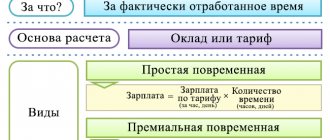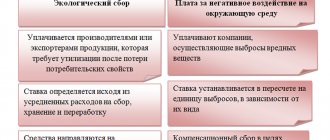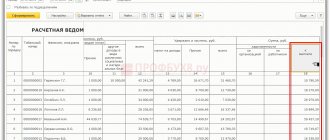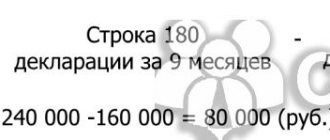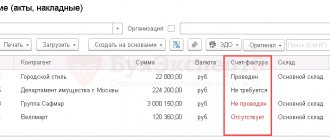Features of calculation work
It is necessary to pay a fee if the enterprise has the following types of negative impacts on the surrounding air:
- discharge of pollutants into water bodies;
- disposal of waste at a landfill;
- emissions of pollutants into the atmosphere.
When determining the amount of the fee, the Nature User must use the payment base. This is a general concept, so resource users do not always understand what the legislator means by this term. The payment base is compiled from information on the volume or mass of emissions, pollutants, as well as data on how much production and consumption waste was disposed of during the reporting period. That is, even if there are as many as 12 months left before payment, you need to start doing some work so that later you can easily calculate the amount of the payment.
Each enterprise and individual entrepreneur independently carries out work to compile the payment base necessary to determine the amount of the fee. It is necessary to conduct laboratory research, carry out industrial environmental control and other work at each facility and maintain document flow separately for each source of emission or environmental pollution.
Fee rates for negative impact are established for each pollutant according to its hazard class. Since the state has set the task of stimulating enterprises and individual entrepreneurs to actively carry out measures and work to reduce the negative impact, then from January 1, 2022, coefficients of 0, 1, 25, 100 will be used to determine the amount of the fee. From the amount of the fee, you can deduct those expenses that incurred by the enterprise (or individual entrepreneur) when implementing measures to reduce NVOS. If they were actually carried out by persons obligated to pay the fee, and there are supporting documents, then in this case the amount of the fee may be less.
You should not count on the fact that when determining the size of the boards, you can enter data that does not correspond to reality or distort the information on the board. The established procedure states that if, from January 1, 2022, a reduction in the volume or mass of emissions arising during the operation of the facility is not confirmed, the measures taken to improve environmental efficiency do not lead to a reduction in discharges of pollutants, then in this case a recalculation will be carried out the size of fees using a coefficient of 100. Today, the state behaves quite harshly towards violators; strict control is exercised over enterprises and individual entrepreneurs whose activities lead to a negative impact on the environment.
When calculating the environmental fee, it is necessary to take into account a number of parameters, that is, there is no fixed and uniform fee for all organizations. The enterprise carries out calculations and submits to Rosprirodnadzor the relevant documents on the basis of which environmental calculations were carried out. It is worth considering that the amount of the fee must be justified: penalties are provided for failure to pay environmental payments, so it is so important that the calculation of the environmental payment is carried out accurately. If environmental payments are made later than the established deadlines, penalties are charged for each calendar day of delay.
It is worth considering that the calculation of the fee depends not only on the category of the object, but also on the volume or mass of emissions and waste discharges. In general, there are several nuances that should be kept in mind when determining the size of the boards. Despite the fact that objects are divided into categories, each source of emissions is still unique, and its characteristics must be considered individually.
Calculation of permissible emission standards
Arbitrage practice:
The enterprise is appealing the decision of the territorial Office of Rosprirodnadzor to refuse to adopt the Declaration of Environmental Impact.
The company was refused.
The court found that the Enterprise carries out economic activities at a facility that has a negative impact on the environment, the category of the facility is NVOS – II.
The enterprise submitted an Environmental Impact Declaration for the facility that has a negative impact to the territorial Office of Rosprirodnadzor.
The Department found that in violation of the requirements of Order of the Ministry of Natural Resources and Ecology of the Russian Federation dated October 11, 2018 N 509 “On approval of the form of the declaration of environmental impact and the procedure for its completion, including in the form of an electronic document signed with an enhanced qualified electronic signature ", the calculation of permissible emission standards was not presented.
This circumstance was the basis for issuing an order to the Enterprise, which ordered it to submit a declaration on the impact on the environment with the appendix of the calculation of permissible emission standards and the issuance of decisions to impose administrative punishment on an official and a legal entity under Article 8.5 of the Code of Administrative Offenses of the Russian Federation.
The enterprise again submitted to the territorial Office of Rosprirodnadzor the Declaration of Environmental Impact for the facility that has a negative impact in the form approved by Order of the Ministry of Natural Resources of Russia dated October 11, 2018 N 509 “On approval of the form of the Declaration of Environmental Impact and the procedure for filling it out, including including in the form of an electronic document signed with an enhanced qualified electronic signature.”
Rosprirodnadzor informed the applicant that the Declaration was submitted in violation of the form and procedure established by Order of the Ministry of Natural Resources and Ecology of the Russian Federation dated October 11, 2018 N 509 “On approval of the form of the declaration of environmental impact and the procedure for its completion, including in the form of an electronic document , signed with an enhanced qualified electronic signature", namely:
— The presented report on the inventory of emissions of harmful (pollutant) substances into the air and their sources is not a calculation of permissible emissions of pollutants into the atmosphere, which contradicts paragraph 12 of Order No. 509,
— recommended to eliminate the comments and send them in the prescribed manner.
For activities at category II facilities, the provisions of Article 31.2 of Federal Law No. 7-FZ provide for the preparation of an environmental impact declaration.
The crux of the matter:
The enterprise attached to the Declaration a Report on the inventory of emissions of harmful (pollutant) substances into the atmospheric air. The enterprise indicated that the calculation of standards for emissions of pollutants into the atmosphere is reflected in the inventory report.
However, neither the inventory report nor the calculation of emission standards as part of the inventory report is a calculation of permissible emission standards.
The form and procedure for filling out the environmental impact declaration are determined by Order No. 509, according to which the calculation of permissible emission standards is a mandatory appendix to the submitted environmental impact declaration; by virtue of paragraphs 22, 23 of Order No. 509, section IV of the declaration is filled out on the basis of calculations standards for permissible emissions, which is attached to the declaration, section V is also filled out based on the calculation of the standard that is attached to the declaration.
Refusal to accept the Declaration, return of the declaration due to unreliable, incomplete, distorted information, replacement, or making changes and additions to a previously submitted declaration are not provided for by law, at the same time, in accordance with the requirements of Article 31.2 of Law No. 7-FZ, Order No. 509, the declaration is subject to acceptance by the territorial bodies of Rosprirodnadzor only if the form and content of the declaration comply with the requirements established by law (letter of Rosprirodnadzor dated 13.01.2020 N AA-03-02-31/334, letter of Rosprirodnadzor dated 26.10.2020 N RN-09-01-32/ 36533).
Compliance of the submitted declaration with the requirements of current legislation is established only as part of the implementation of control measures by the Department.
However, due to the fact that the Enterprise submitted the environmental impact declaration to the Department again, as part of eliminating violations of the law specified in the order previously issued by the Department, the Department informed the organization in a letter that the re-submitted declaration also does not comply with the requirements of the current legislation.
The Company's argument that the calculation of permissible emission standards was included in the inventory report attached to the Declaration was rejected by the court.
The courts noted that neither the inventory report nor the calculation of emission standards as part of the inventory report constitutes a calculation of permissible emission standards.
According to the requirements of paragraph 22 of Order No. 509, section IV of the declaration is filled out on the basis of calculations of permissible emission standards, which is attached to the declaration. In the specified section “Mass of pollutant emissions”, the mass of pollutant emissions within the limits of permissible emission standards is prescribed, among other things.
Rejecting the society's argument that the calculation of permissible emission standards is included in the inventory report attached to the Declaration of Environmental Impact for an object that has a negative impact, the courts proceeded from the fact that, in accordance with the requirements of paragraph 22 of Order No. 509, section IV of the declaration is filled out based on calculations of permissible emission standards, which are attached to the declaration. In the specified section “Mass of pollutant emissions”, the mass of pollutant emissions within the limits of permissible emission standards is prescribed, among other things.
According to paragraph 11 of the Order of the Ministry of Natural Resources of Russia dated August 11, 2020 N 581 “On approval of the methodology for the development (calculation) and establishment of standards for permissible emissions of pollutants in the sanitary and epidemiological welfare of the population” (Collected Legislation of the Russian Federation, 1999, N 14, Art. 1650) ;
11) applications (if necessary).
On paper, materials must be signed and certified by a seal (if any) of a legal entity or individual entrepreneur carrying out economic and (or) other activities at the ONV facility.
According to paragraph 5 of the Order of the Ministry of Natural Resources of Russia dated August 11, 2020 N 581 “On approval of the methodology for developing (calculating) and establishing standards for permissible emissions of pollutants in the sanitary and epidemiological welfare of the population”, the hygienic quality standard is certified on the basis of a sanitary and epidemiological conclusion issued by the relevant territorial body Rospotrebnadzor.
Therefore, in order to confirm that the emission standards calculated as part of the annex to the declaration will not have a negative harmful effect on the environment and human health, a simple calculation of qualitative and quantitative emission parameters (inventory) is not enough; it is necessary to confirm their compliance with established sanitary and epidemiological rules and standards .
Thus, at the time of filing the declaration, the admissibility of the values specified in section IV of the declaration was not properly confirmed by the company.
What determines the amount of payment for negative impact on the environment?
Calculation of fees for environmental impact assessments in all cases is carried out in accordance with the Decree of the Government of the Russian Federation “On the calculation and collection of fees for negative impacts on the environment” dated March 3, 2017.
The amount of the environmental payment depends on the volume of emissions and discharges of pollutants and waste disposed. When projects are approved, regulatory structures set limits on waste disposal, standards for waste generation, standards for emissions and discharges, which must be taken into account when making calculations. If a legal entity or individual entrepreneur untimely provides a technical report on the unchanged production process or a report on PEC, waste is buried that is not specified in the document approving the disposal limit, exceeds the permitted volumes of emissions, discharges or waste disposal; in this case, increasing coefficients are applied when calculating the eco-payment (25 or 100 times).
Calculation of permissible discharge standards
VAT is not subject to revision during the period for which a comprehensive environmental permit is issued, in the application for which they were contained, or for which an environmental impact declaration is submitted, to which they were annexed, as well as the period for which they are approved in cases provided for in Part 1.1 of Article 11 of Federal Law N 219-FZ, except for the occurrence of circumstances for calculating new VAT specified in paragraph 13 of this Methodology.
The validity period of VAT calculations does not exceed 7 years from the date of receipt of the comprehensive environmental permit in the application for which they were contained (except for the cases provided for in paragraph 13 of Article 31.1 of Federal Law No. 7-FZ), or this period is calculated from the moment the impact declaration is submitted on the environment to which they were an attachment.
In the cases provided for in Part 1.1 of Article 11 of Federal Law N 219-FZ, VAT is approved for 5 years in accordance with paragraph 1 of Decree of the Government of the Russian Federation of July 23, 2007 N 469 “On the procedure for approving standards for permissible discharges of substances and microorganisms into water bodies for water users".
paragraph 11 of the order of the Ministry of Natural Resources of Russia dated December 29, 2020 No. 1118
If your enterprise has undergone a change in technology, resulting in the formation of new sources of pollutant emissions, new names of pollutants, then it becomes necessary to submit a declaration without waiting for the expiration of the 7-year period. At the same time, you must update information about the ENVOS.
Procedure for calculating environmental payments
When carrying out calculation work, various environmental regulatory documents are analyzed. This is necessary to obtain reliable data on the volume of waste generated during production or consumption, the amount of pollutants discharged into water bodies and emissions into the atmosphere. To carry out work on calculating the eco-payment, you need:
- VAT project permit,
- permit for the MPE project,
- DVOS,
- PEC and report on PEC,
- limits for the PNOLR project and other documentation.
After analyzing these documents, you can determine the period for calculating the eco-payment and the cost of the service.
Declaration form?
On February 22, 2022, Order of the Ministry of Natural Resources dated January 09, 2017 No. 3 “On approval of the Procedure for submitting a declaration on payment for negative impact on the environment and its forms” was registered with the Ministry of Justice and published, i.e. came into force.
The fee for the IEE must be paid no later than March 1 . Therefore, those who did not use the unpublished Procedure to calculate the amount of the fee have three days left (including holidays) to calculate and pay the fee for the NVOS. Starting from 2022, a penalty in the amount of 1/300 of the key rate of the Bank of Russia .
The fee is paid separately for four environmental components: emission fee, APG emission fee, discharge fee and waste disposal fee. Each with its own BCC (budget classification code). It should be taken into account that if advance payments were made and, for example, there was an overpayment for waste, then it cannot be automatically included in the payment for emissions, because These components are paid according to different BCCs. The calculated total amounts of the fee for payment for the reporting period (lines 151 - 154 of the Declaration) are subject to payment; the amounts of the fee for return and/or offset (lines 161 - 164) should not affect the amount of the current payment .
Order of the Ministry of Natural Resources No. 3 determines the form of the Declaration itself, which must be submitted no later than March 10 . The Excel formatted Declaration form can be downloaded from our website here.
Attention! In line 010 on the sheet “Calculation of the fee amount” of the Declaration, the code of the municipality (OKTMO) is indicated on the territory of which the stationary source or waste disposal facility (WWF) of production and consumption ; it should not be confused with the waste generation facility. In the Declaration form, line 010 has 11 characters for entering OKTMO, but you only need to indicate the first 8 characters of OKTMO, and write zeros in the 10th and 11th positions.
Documents required for calculating eco-payments
List of documents required for calculating environmental payments:
- details of an individual entrepreneur or legal entity (telephone, address, full name of the general director and chief accountant, email, etc.);
- copies of constituent documents: INN, OGRN, Charter, KPP, certificates from the State Statistics Committee;
- copies of emission fee calculations for the previous year (if available);
- copies of discharge fee calculations for the previous year (if available);
- limit on waste disposal;
- emission permit;
- data on vehicles on the enterprise’s balance sheet;
- agreement for the transfer of waste to licensed organizations specializing in waste collection and disposal;
- waste transfer acts, certificates for the current and previous years;
- copies of payment documents confirming payment of fees for the tax assessment for the current and previous years;
- PEC report.
Fee amount
1. On the “Fee Amount” tab, you need to indicate the “Object Category” and “Object Code”.
2. In the fields “Amount of funds to reduce the environmental impact”, the amounts of fees spent on environmental protection measures to reduce the negative impact of emissions, discharges and waste disposal are indicated.
3. In the fields “Advance for emissions”, “Advance for APG”, “Advance for discharges” and “Advance for waste” the amounts of advance payments for the first three quarters of the year are entered. The remaining fields are calculated automatically.
Calculation of advance payments
Legal entities and individual entrepreneurs must make an advance eco-payment quarterly - with the exception of small and medium-sized businesses. Payment must be made no later than the 20th day of the month following the reporting period. It is important that the calculations are not required to be submitted in any form (paper or electronic). The last part of the eco-payment is paid on March 1 of the year following the reporting year.
According to Law No. 450-FZ, payers can choose one of three methods for calculating the amount of advance payments:
- In the amount of one-fourth of the amount of the fee for the NVOS payable (taking into account the adjustment of the amount of the fee carried out in accordance with paragraphs 10−12.1 of Article 16.3 of Law No. 7-FZ) for the previous year;
- In the amount of one-fourth of the amount of the fee for the NVOS, in the calculation of which the payment base is determined based on the volume or mass of emissions of pollutants, discharges of pollutants within the limits of permissible emission standards (PER), permissible discharge standards (VAT), temporarily permitted emissions (TPR) , temporarily permitted discharges (TPD), limits on the disposal of production and consumption waste;
- In the amount determined by multiplying the payment base, which is calculated on the basis of industrial environmental control (PEC) data on the volume or mass of emissions, discharges of pollutants, or the volume or mass of industrial and consumption waste disposed in the previous quarter of the current reporting period, by the corresponding rates of payment for NVOS using the coefficients established by Art. 16.3 of Law No. 7-FZ.
Who is required to submit a declaration regarding the payment for the tax assessment?
- Legal entities or individual entrepreneurs operating under ENVOS categories 1-3.
- Legal entities or individual entrepreneurs operating on ENVOS category 4 if there are ENVOS categories 1-3 (RPN letter below).
- Legal entities or individual entrepreneurs who are not UNVOS categories 1-4 or not registered with the VET UONVOS.
Letter of Rosprirodnadzor dated February 21, 2017 N AS-06-02-36/3591 “On payment for negative impact on the environment”
ABOUT FEES FOR NEGATIVE IMPACT ON THE ENVIRONMENT
In order to resolve issues arising in the exercise of powers to administer budget revenues of the budget system of the Russian Federation from fees for negative impacts on the environment, the Federal Service for Supervision of Natural Resources informs about the following.
By virtue of Art. 16 of Federal Law No. 7-FZ of January 10, 2002 “On Environmental Protection” (hereinafter referred to as Law No. 7-FZ), fees for negative impacts on the environment are charged for the following types:
-emissions of pollutants into the atmospheric air from stationary sources;
-discharges of pollutants into water bodies;
-storage, burial of production and consumption waste (waste disposal).
Paragraph 1 part 1 article 16.1 of Law No. 7-FZ excludes from the number of persons obligated to pay a fee for negative impact on the environment, legal entities and individual entrepreneurs carrying out economic and (or) other activities exclusively at Category IV facilities.
Thus, the legislation does not provide for the collection of fees for the established Art. 16 of Law No. 7-FZ types of negative impact on the environment from legal entities and individual entrepreneurs carrying out economic and (or) other activities exclusively at category IV facilities.
Moreover, if a legal entity or individual entrepreneur simultaneously has objects of category IV and objects belonging to other categories defined by law (I, II, III), payment for the negative impact on the environment is calculated and paid for all objects, including objects of IV categories.
Note on the following: new Criteria have come into force, the letter refers to the old ones...
At the same time, it is necessary to pay attention that the current legislation does not provide for the obligation to place objects that have a negative impact on the environment on state registration, which do not belong to objects of categories I, II, III and IV, approved by Decree of the Government of the Russian Federation of September 28, 2015 N 1029 “On approval of criteria for classifying objects that have a negative impact on the environment as objects of categories I, II, III and IV” (hereinafter referred to as the Criteria).
Thus, if a facility generates production and consumption waste, but there are no other types of negative impacts on the environment specified in the Criteria (clause 6 of the Criteria), such a facility is not subject to registration as an facility that has a negative impact on the environment Wednesday (not included in the state register of objects, an application for registration is not submitted).
At the same time, it should be noted that the Criteria are currently being revised taking into account issues of waste management and obtaining permits.
According to para. 2 hours 1 tbsp. 16.1 of Law No. 7-FZ, payers of fees for the negative impact on the environment when disposing of waste, with the exception of solid municipal waste, are legal entities and individual entrepreneurs whose economic and (or) other activities generated waste. Payers of fees for the negative impact on the environment when disposing of municipal solid waste are regional operators for the management of municipal solid waste, operators for the management of municipal solid waste, carrying out activities for their disposal.
These provisions are also enshrined in Parts 4 and 5 of Art. 23 of Federal Law No. 89-FZ of June 24, 1998 “On Production and Consumption Waste” (hereinafter referred to as Law No. 89-FZ):
- payment for the negative impact on the environment when disposing of waste (with the exception of solid municipal waste) is carried out by individual entrepreneurs, legal entities, in the course of whose economic and (or) other activities waste is generated;
- payers of fees for the negative impact on the environment when disposing of municipal solid waste are operators for the management of municipal solid waste, regional operators carrying out activities for their disposal.
Article 1 of Law No. 89-FZ defines the following concepts:
waste disposal - storage and disposal of waste;
municipal solid waste management operator - an individual entrepreneur or legal entity engaged in the collection, transportation, processing, disposal, neutralization, and burial of municipal solid waste;
regional operator for the management of municipal solid waste - an operator for the management of municipal solid waste - a legal entity that is obliged to enter into an agreement for the provision of services for the management of solid municipal waste with the owner of the solid municipal waste that is generated and the collection sites of which are located in the area of activity of the regional operator.
Federal Law dated December 28, 2016 N 486-FZ “On Amendments to Certain Legislative Acts of the Russian Federation” Federal Law dated June 24, 1998 N 89-FZ “On Production and Consumption Waste” and Federal Law dated December 29, 2014 N 458- Federal Law “On Amendments to the Federal Law “On Production and Consumption Waste”” changes have been made regarding the management of municipal solid waste, in particular, changes to extend the deadline for payment of fees for utility services for the management of municipal solid waste (no later than 01/01/2019 ) in the presence of a concluded agreement between the executive authority of the constituent entity of the Russian Federation and the regional operator for the management of municipal solid waste (no later than 01.05.2018) and an approved uniform tariff for the service for the management of solid municipal waste on the territory of the corresponding constituent entity of the Russian Federation (no later than 01.07 .2018).
At the same time, during this period, individual entrepreneurs and legal entities carrying out licensed activities for the collection, transportation, processing, disposal, neutralization, and disposal of solid municipal waste continue to operate. The specified business entities correspond to the status of operators for the management of municipal solid waste established in Art. 1 of Law No. 89-FZ, the provisions of which do not contain any additional conditions.
Thus, for 2016 and until the selection of a regional operator for the management of municipal solid waste in the constituent entities of the Russian Federation, the conclusion of an agreement between the executive authority of the constituent entity of the Russian Federation and the regional operator for the management of municipal solid waste and the approval of a single tariff for the service for the management of municipal solid waste municipal solid waste, in accordance with the law, fees for the negative impact on the environment when disposing of municipal solid waste are charged to municipal solid waste management operators - legal entities or individual entrepreneurs carrying out specialized activities for the disposal of municipal solid waste.
I instruct you to remove clarifications from territorial bodies containing a different legal position from the official websites of territorial bodies on the Internet.


